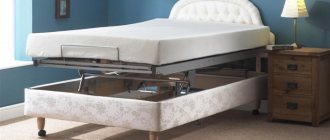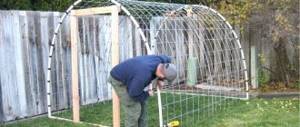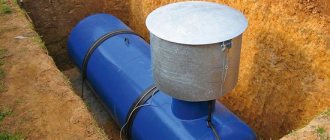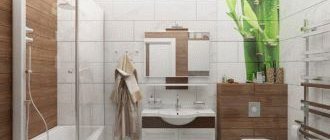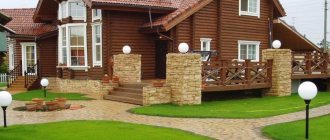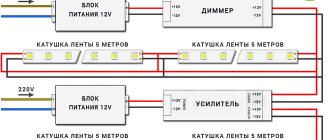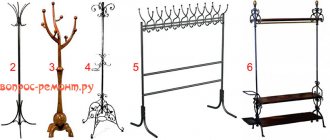What is a coaxial chimney for a gas boiler
The method consists of a two-row arrangement of pipes through which combustion products exit and fresh air enters when operating two-chamber boilers. The classic chimney system forcibly draws air from the room into the combustion chamber. The coaxial model takes air from the street and forces it into the firebox.
Combustion products exit through the inner pipe to the street, and a flow of fresh air moves towards the boiler. A heat exchange effect occurs.
The principle of operation of the chimney is based on the attraction of the flow of outside air and the removal of combustion products
Fresh air enters the firebox in a heated state, this increases the efficiency of the gas boiler. Due to heat exchange, the hot air at the outlet cools and comes out not hot, but warm, which significantly reduces the temperature of the pipe and allows the chimney design to be classified as safe.
Constructions are distinguished by types:
- External and internal location of the chimney. External devices are attached to the outer part of the wall of the building; for internal devices, a channel is built indoors
- Insulated and non-insulated structures. In regions with cold, harsh winters, experts recommend insulating the canal. However, this leads to a decrease in operating efficiency due to the fact that the supply of oxygen to the firebox is reduced. Insulated chimney systems ensure continuous operation of heating equipment at low air temperatures. Chimney insulation is a must for northern regions
- Collective and individual chimney systems. Collective ones are placed in cases where several heating devices are located along the riser
- Horizontal and vertical placement. Installation methods are selected individually for each home
An important advantage of the coaxial method is that the air intake for the furnace comes from the street. As a result, installation requirements for the necessary ventilation in the boiler room are reduced.
System advantages:
- quick installation;
- suitable for any type of heating device;
- good traction performance if all installation rules are followed;
- possibility of use in multi-storey buildings;
Flaws:
- during installation, additional approval from the Sanitary and Epidemiological Supervision Authority is required; Attention! When operating a two-channel system, toxic condensate is released, which requires proper disposal. Insulating the pipe will prevent its formation.
- Improper installation can lead to icing of the tip and reduced traction. Icing of the tip is a consequence of improper organization of the chimney
Advantages
So, what are the advantages of a coaxial chimney system?
The advantages of the innovative device are:
- long service life - life expectancy more than 50 years;
- resistance to wear – the system resists the destructive influence of climatic, mechanical, biological, thermal factors;
- practicality - the structure does not pass through the roof, so there is no need to violate its integrity;
- safety - the risk of fire in the area of contact of certain flammable surfaces with the smoke exhaust system is reduced, since the internal pipe is perfectly cooled by the external one;
- environmental friendliness - the smoke exhaust promotes complete combustion of fuel, so the number of unburned particles emitted into the air is significantly reduced;
- efficiency - there is no need to organize additional ventilation, since substances harmful to the human body do not enter the home;
- compactness - the chimney has optimal dimensions, resulting in space saving;
- extremely wide range - choosing the right sample for a particular system is not difficult;
- efficiency - increasing the efficiency due to warming the incoming cold air mass on a heated pipe;
- easy installation - no special skills or knowledge required.
We invite you to familiarize yourself with: Pool bowls: made of composite, acrylic and PVC, installation and finishing, composition, metal and concrete, monolithic and prefabricated
The advantages are impressive. Is not it? Let's move on to the disadvantages.
Coaxial chimney device for a gas boiler
The entire structure consists of:
- main body - straight pipes;
- decorative overlays;
- tees;
- seals;
- couplings that serve as bends at 90 0 and 45 0;
- fittings, adapters, components, clamps and brackets;
- viewing windows;
- devices for removing condensate.
The coaxial smoke exhaust device includes several components.
The external channel acts as a cooling device that lowers the temperature of the pipeline on the surface. This eliminates the need to build additional structures for fire protection.
Dimensions of a coaxial chimney for a gas boiler
According to the safety standards regulated in SP 60.13330, it is important to follow the following rules:
- it is recommended to slope the horizontal element by 3 0 towards the gas appliance;
- maximum length from 3 to 5 m;
- turning corners are allowed to be used no more than 2 times;
- when placed in a brick wall, a gap of 1 cm is made;
- the gap is covered with a safe cover;
- the chimney duct in a wooden house is widened by 5 cm from the width of the chimney and sealed with basalt insulation or fire-resistant foam;
- for cleaning, install a tee with a condensate collector; Requirements for the placement of the chimney must be met
- the shortest exit distance is not lower than 2 m from the ground.
Experts recommend installing the chimney system strictly in accordance with the instructions supplied with the pipe.
Inclination of the coaxial pipe of a gas boiler
According to some craftsmen, the slope for condensate drainage should be made towards the room, while others argue that it should be towards the ground. However, these disputes led to manufacturers creating a device to collect condensate. In this case, the tilt must be set towards the heating device.
Attention! When the pipe is tilted outward in winter, icing of the tip occurs, which leads to a decrease in draft and efficiency of the boiler.
Manufacturer specialists strongly recommend making an inward slope, since prolonged operation of a gas appliance with an icy pipe leads to serious damage to the device.
If there is a slope towards the boiler, condensation collects in the combustion chamber. Manufacturers have developed a condensate collector that is installed inside the firebox. Experts have also developed a kit that contains an extension nozzle for the internal chimney pipe. It has a built-in protective spiral. When installing this kit, it is recommended to place the air intake holes at the bottom.
Manufacturer
So, which manufacturer should you choose?
The reputation of the following manufacturers is as pure as a child’s tear:
- "Baksi" is a company that creates first-class quality structures;
- Burderus is a company that produces extremely reliable devices;
- “Herman” is an organization that creates high-quality chimneys;
- “Vailat is a manufacturer that delights its fans with durable products;
- "Navien" is a company that produces wear-resistant products;
- "Viesman" is an organization that creates chimneys that have a long lifespan;
- “Proserm” is a company that cares not only about its income, but also about the quality of its products;
- Daewoo is a company that produces products that resist the negative effects of environmental factors;
- Ariston is a company that creates products that have no competitors.
Thus, the choice is yours!
Rules for installing a coaxial chimney for a gas boiler
Covers the procedure for installing a coaxial pipe for a double-circuit gas boiler SNiP 2.04.08-87 and 2.04.05-91. Failure to follow the recommendations will result in gas service workers refusing to accept incorrectly installed equipment.
SNiP regulates:
- When placing the chimney externally, it is necessary to place the head at least 2 m from the ground. The size of the hole exceeds the diameter of the pipe by 1 cm in a brick wall, by 5 cm in a wooden one.
- The smoke exhaust duct is installed at a distance of 0.5 m from windows and doors. The window, which is located above the pipe, is located at a distance above 1 m.
- The wall is 30 cm from the chimney. For turbocharged boilers, the value is increased to 1 m.
- Installation of a narrowing diaphragm is mandatory.
- The chimney pipe is located at a distance of 1.5 m from neighboring houses. The presence of trees, outbuildings and other objects is also unacceptable.
- It is recommended to use a basalt slab as insulation.
- Do not allow condensation to reach the ground. The horizontal part is mounted at an angle to the boiler and a condensate intake kit is installed. In the case of installing a collective smoke exhaust system, it becomes necessary to coordinate the disposal of condensate with the Sanitary and Epidemiological Supervision service.
- When installing a collective smoke exhaust system, the rules prohibit connecting to a single network with forced and natural exhaust systems.
- The need for additional routing of the site is acceptable through a service building in which people do not live. The length of the extended element with natural tapping is up to 3 m, with forced tapping - up to 5 m.
- Chimney maintenance must be provided every heating season in the fall and spring. When checking, special attention is paid to the tightness of the joints. If an accumulation of condensate is detected, it is removed.
Diagram of a coaxial chimney for a gas boiler
The photo shows drawings of a coaxial chimney for a gas boiler:
Comparison of the traditional and double-circuit chimney method The operation of the supply and exhaust system is strictly regulated The horizontal method of installing a supply and exhaust chimney Options for collective placement of a chimney for a gas water heater Assembling a chimney for a traditional water heater The dimensions of the chimney elbow are an important parameter The simplest example of installing a chimney can be done even by novice builders Air flows at operation of the supply and exhaust structure
Installation options for a coaxial chimney for a gas boiler
There are horizontal and vertical methods of equipment installation. The choice depends on the boiler room. One of the important conditions: there should be no foreign objects on the installation wall.
In a wooden house, all elements of the heating system are mounted on a metal protective sheet
Horizontal installation of a coaxial pipe of a gas boiler
Before installation, find out:
- the presence of buildings and plantings near the installation;
- the presence of door and window openings for neighbors;
- proximity of windows and doors in the building;
- distance from the pipe to the hole;
- number of rotating elements;
- the need to extend the pipe.
Having collected all the specified data, the readings are checked against the rules of SNiP. If all the requirements are met, then proceed to the direct installation of the coaxial chimney. If it is impossible to meet the requirements, then choose the vertical method of installing the chimney system.
Experts advise that the angle of inclination be carried out following the recommendations of the gas boiler manufacturer. For the double-circuit type, it is recommended to make the slope towards the boiler; for the classic device, it is made towards the ground. If the pipe is tilted outward, then experts advise insulating the channel.
Vertical installation of a coaxial chimney for a gas boiler
In cases where it is impossible to build a heating structure using a horizontal method, a vertical installation of a coaxial chimney for a gas boiler is used. When it becomes necessary to build a shaft through a roof structure, you should remember fire safety issues and use insulating pipes and protective covers during installation. Fire-resistant insulating elements are used as insulating materials.
Attention! Experts recommend leaving an air gap between the roofing section and the pipe. However, the exit point should be carefully sealed and covered with a thick casing.
Options for vertical mounting of the tip pipe
Installation is carried out in one of 2 ways: external or internal. Experts recommend thermal insulation using any of the selected methods.
Classification
So, what types of devices are there? There is the following classification of structures.
1.) Location. There are such devices:
- internal - laid in mines;
- external - located on the inside of the facade in order to avoid deteriorating the appearance of the building.
2.) Insulation. There are such devices:
- insulated - used in regions where low temperatures prevail for a long time;
- not insulated - used in areas where high temperatures reign for a long time.
3.) Output type. It depends on the location of the boiler in the room and the path along which the chimney is laid. There are structures with the following conclusion:
- vertical;
- horizontal.
4.) Amount of equipment. Options available:
- individual - intended to serve one boiler and do not differ in the presence of branches;
- collective – systems where individual branches are connected to a common channel.
As you can see, the choice is good and rich.
How to assemble a coaxial pipe for a gas boiler
The system is assembled in the following order:
- the base is connected to the outlet from the boiler;
- fix the lower part of the pipe with a clamp;
- fasten elements;
- joints are treated with sealant;
- check the functionality of the structure and make the first launch.
The internal part of a coaxial chimney
According to the rules, 3 fittings or 2 elbows are installed on a 3 m section of pipe. All joints are pressed tightly and carefully against each other. The fewer connections there are, the more reliable the system.
Flaws
So, what are the negative aspects of the devices?
Coaxial chimneys have the following disadvantages:
- cost – the price of innovative devices is 40% higher compared to separate devices;
- condensation formation - concentric placement of pipes with hot and cold air promotes the formation of condensation, which is why there is a need for insulation or moisture removal.
- high cost of repairs - if one or another part in the structure fails, a significant investment will be required to carry out the repair.
High price. A stingy person pays twice. Condensate. Special elements available on the market solve this problem. Expensive repair work. A careful attitude is the way out of the situation. And no matter how you look at it: the innovative device deserves attention.
Having considered the pros and cons of coaxial chimneys, it’s time to move on to their types.
How to properly install a coaxial chimney for a gas boiler
Each manufacturer of a coaxial chimney for a gas boiler provides a set of operating instructions for the consumer. Mistakes made during installation can lead to equipment failure. Installation work is carried out in the following sequence:
- Install the boiler, measure the center of the chimney, drill a hole in the wall, and, if necessary, fill the space with a basalt slab or fire-resistant foam.
- Assemble the coaxial system.
- The pipe is taken outside and the angle of inclination is checked.
After completing the installation process, be sure to check the tightness of the joints
Advice from professionals
Reliable connection of pipes will be ensured by transition units. All joints must be covered with sealant and a protective casing.
In order for gas equipment to be accepted for warranty by the service center, it is necessary to install the recommended coaxial chimney system for the selected boiler.
You should not neglect the help of specialists and carry out the installation yourself without the proper experience.
Incorrect calculation leads to a change in outlet temperature and increased condensation formation. As a result, ice accumulates on the tip. It is mandatory to install metal shields in wooden rooms.
Protective units increase the cost of the structure, while increasing its performance. When installing vertically, a valve is always installed to increase draft and a condensate collection kit is installed.
Horizontal systems are additionally equipped with an anti-icing module, wind protection and a diaphragm.
